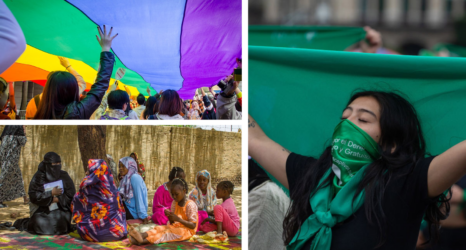Gerard Koskovich, a curator at the The GLBT History Museum in San Francisco, remembers when the term LGBT first came about (the 1990s), and has seen it spread around the world to describe lesbian, gay, bisexual and transgender people. Today’s the perfect time to recall the acronym’s origins, since it’s the start of National LGBT History Month.
The word “gay” emerged as underground slang referring to both men and women homosexuals in the 1940s and 50s, but lesbians soon felt left out because people tended to associate gay with men. Gay women then claimed “lesbian” as their identification during the ’60s and ’70s feminist movements, and the common expression became “gay and lesbian” to describe all queer folk. Women hoped the change would give lesbians more visibility and boost their status to more than a footnote to gay men, says Koskovich.
Bisexual and transgender people were added to the description in the late 1990s—long after activists first demanded inclusion. Rightfully, they had felt excluded because bisexual people weren’t gay and “transgender” refers to gender identity, not sexual orientation. Among many others, bisexual activist Maggie Rubenstein and transgender activist Susan Stryker pushed organizations already representing their identities to honor them in their names, and the term GLBT emerged as a common term used through the early 2000s.
Gay, lesbian, bisexual and transgender identities have long been historically tied. In the 19th century, people believed sexual desire could only happen between a male and female, so they saw gay couples as having a male and female component. They referred to some queer people as the “third sex,” meaning a person having a woman’s soul in a man’s body, or vice versa.
With broad social changes over the next 200 years, many finally began to see gay and transgender as separate categories, but they stayed intertwined. Even in the 1990s, doctors used hormones and gender-reassignment surgery to try to “cure” homosexuality. People designated female at birth wanting to physically transition had to prove they wouldn’t end up gay men, says Koskovich. Because of this, trans activists such as Lou Sullivan, the gay founder of FTM International, sought out doctors who wouldn’t refuse to prescribe hormones or perform gender-reassignment surgery because of a patient’s sexual orientation, and today the U.S. medical field doesn’t bar people from physically transitioning because of their sexual orientation.
LGBT eventually replaced GLBT as the most common term in the mid-2000s, perhaps to again give lesbians more visibility. But people constantly need new words or letters to describe emerging identities and social roles, notes Koskovich, so today there is no single correct term. Some use the term LGBTIQ to include intersex, queer and questioning people, or go even longer—to LGBPTTQQIIAA+ (meaning lesbian, gay, bisexual, transgender, transsexual, queer, questioning, intersex, intergender, asexual, ally and beyond). Others use queer as an umbrella term, which is easier to say and fun to throw in the face of oppressors. But it also brings back an invisibility problem for lesbians, bisexual and transgender people. Also, labeling an organization “queer” can isolate and be hurtful to older people who still view it as the hateful insult they faced during the ’50s and ’60s.
“[Naming is] ultimately a discussion about respect,” says Koskovich, “a discussion about who is given visibility, a discussion about how power is distributed. … It’s not just a debate about an acronym or a set of terminology. That’s the proxy for discussion about social change, social power, respect, self respect, visibility—a variety of things that are absolutely essential to people’s ability to live in the world and feel that their experience and desire and sense of self is being honored.”
Amy Sueyoshi, associate dean of ethnic studies at San Francisco State University, and Rich Wandel, archivist and historian at the Lesbian, Gay, Bisexual and Transgender Community Center in NYC, also provided valuable insights for this story.
Photo from Flickr user The Other Queen under license from Creative Commons 2.0.





